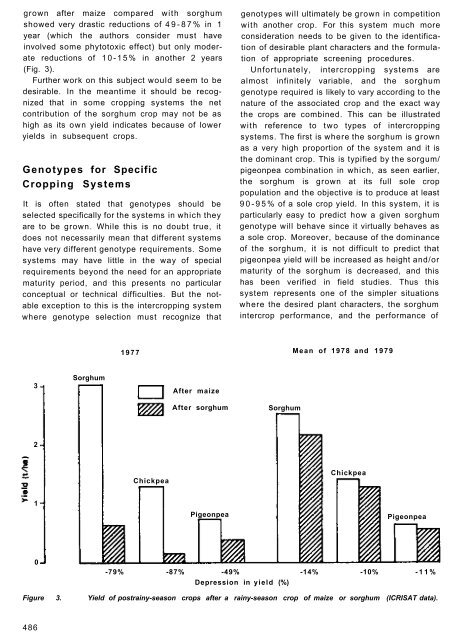RA 00048.pdf - OAR@ICRISAT
RA 00048.pdf - OAR@ICRISAT
RA 00048.pdf - OAR@ICRISAT
You also want an ePaper? Increase the reach of your titles
YUMPU automatically turns print PDFs into web optimized ePapers that Google loves.
grown after maize compared with sorghum<br />
showed very drastic reductions of 4 9 - 8 7 % in 1<br />
year (which the authors consider must have<br />
involved some phytotoxic effect) but only moderate<br />
reductions of 1 0 - 1 5 % in another 2 years<br />
(Fig. 3).<br />
Further work on this subject would seem to be<br />
desirable. In the meantime it should be recognized<br />
that in some cropping systems the net<br />
contribution of the sorghum crop may not be as<br />
high as its own yield indicates because of lower<br />
yields in subsequent crops.<br />
Genotypes for Specific<br />
Cropping Systems<br />
It is often stated that genotypes should be<br />
selected specifically for the systems in which they<br />
are to be grown. While this is no doubt true, it<br />
does not necessarily mean that different systems<br />
have very different genotype requirements. Some<br />
systems may have little in the way of special<br />
requirements beyond the need for an appropriate<br />
maturity period, and this presents no particular<br />
conceptual or technical difficulties. But the notable<br />
exception to this is the intercropping system<br />
where genotype selection must recognize that<br />
genotypes will ultimately be grown in competition<br />
with another crop. For this system much more<br />
consideration needs to be given to the identification<br />
of desirable plant characters and the formulation<br />
of appropriate screening procedures.<br />
Unfortunately, intercropping systems are<br />
almost infinitely variable, and the sorghum<br />
genotype required is likely to vary according to the<br />
nature of the associated crop and the exact way<br />
the crops are combined. This can be illustrated<br />
with reference to two types of intercropping<br />
systems. The first is where the sorghum is grown<br />
as a very high proportion of the system and it is<br />
the dominant crop. This is typified by the sorgum/<br />
pigeonpea combination in which, as seen earlier,<br />
the sorghum is grown at its full sole crop<br />
population and the objective is to produce at least<br />
9 0 - 9 5 % of a sole crop yield. In this system, it is<br />
particularly easy to predict how a given sorghum<br />
genotype will behave since it virtually behaves as<br />
a sole crop. Moreover, because of the dominance<br />
of the sorghum, it is not difficult to predict that<br />
pigeonpea yield will be increased as height and/or<br />
maturity of the sorghum is decreased, and this<br />
has been verified in field studies. Thus this<br />
system represents one of the simpler situations<br />
where the desired plant characters, the sorghum<br />
intercrop performance, and the performance of<br />
1 9 7 7<br />
Mean of 1978 and 1 9 7 9<br />
3<br />
Sorghum<br />
After maize<br />
After sorghum<br />
Sorghum<br />
2<br />
Chickpea<br />
Chickpea<br />
1<br />
Pigeonpea<br />
Pigeonpea<br />
0<br />
-79% -87% -49% -14% -10% - 1 1 %<br />
Depression in yield (%)<br />
Figure 3. Yield of postrainy-season crops after a rainy-season crop of maize or sorghum (ICRISAT data).<br />
486

















